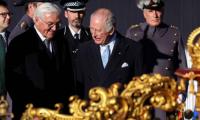On August 15, we woke up to a new world; the Taliban had seized control of Kabul as the government in Afghanistan disintegrated and the president left the country.
The dystopian scenes witnessed at the airport in Kabul on that day were an inevitable result of the West’s grand designs in Afghanistan that were launched two decades ago. On August 15, Kabul fell to a terrorist organization and the dreams of a progressive Afghanistan were shattered. Thus has begun an assault on the identity, culture and history of Afghanistan.
Replacing the tricolour flag of the republic with the banner of the so-called ‘Islamic Emirate’ was the first attempt the Taliban made to erase Afghanistan’s identity. But Afghanistan has changed since the Taliban were last in power; today, there is a new generation of educated, progressive Afghans who were raised on the ideas of democracy, diversity and human rights. These young Afghans are not willing to part with their flag so easily and so they came out on the streets on August 19, Afghanistan’s Independence Day, with women in the lead, proudly and defiantly waving the tricolour. The Taliban were not expecting this resistance; despite beatings and punishments, the people continue to raise the national flag as an act of defiance against the new regime.
US President Biden now blames Afghanistan’s political leaders for the tragic scenes we witnessed in Kabul last week, saying they gave up and fled the country and the military collapsed without trying to fight. But the truth is that Afghanistan was returned to the Taliban under the Doha agreement much earlier, when the United States bypassed the elected government in Kabul and directly made a settlement with the Taliban.
The Doha arrangement provided a framework for an internationally orchestrated takeover of Afghanistan. As many as 6,000 hardened militants were released under the agreement. These fighters then went on to support the Taliban’s onslaught under which the Afghan forces eventually crumbled. Those who were watching the international press were shocked at the unprecedented coverage being given to the Taliban narrative after the Doha deal.
For years, there was a $10 million reward for Sirajuddin Haqqani’s capture. But soon after the Doha agreement, Haqqani was penning articles in The New York Times, where he wrote as the head of a state. In the months leading to the US withdrawal from Afghanistan, CIA reports were leaked to the press which presented a bleak assessment of the Afghan defence forces, and predicted a quick collapse of the government in Afghanistan under the Taliban offensive. The psychological effect of this propaganda blitz on behalf of the Taliban on the Afghan defence forces has been an understated aspect of the discussion around the fall of Afghanistan.
Another aspect that is conveniently ignored in this discussion is how deeply intertwined the Afghan security infrastructure was with the American military, which provided the main logistical, technical and financial support to the Afghan defence forces. When the Americans began to withdraw, bases were evacuated overnight – often without any communication with the Afghan personnel. The speed of these evacuations stunned the whole world, but they had an especially devastating effect on the morale and the ability of the Afghan security forces to resist the Taliban takeover.
A Taliban-led state – in the heart of Central and South Asia – will have devastating consequences for the whole world, and the immediate effects of this will be felt in our region. Afghanistan’s neighbours should be especially concerned. Meanwhile, governments are trying to seek reassurances from the Taliban regime that it will not export terrorism from Afghanistan’s soil and that it will take action against ISIS, ETIM and the TTP. However, it is difficult to believe that the Taliban, a militant outfit with no governing project to offer the people, will be able to prevent its ideological siblings from wreaking destruction across the region.
The people of Pakistan will be the first to be affected by the regrouping of terrorist outfits in Afghanistan. Among the 2,300 prisoners recently released by the Taliban is Maulvi Faqir Muhammad whose first statement was his reaffirmation to the jihadi project in Pakistan. Since the TTP’s reunification, we have seen a spike in targeted attacks against security forces and tribal elders in North Waziristan.
Even as Afghan journalists leave their country, the media elsewhere – including here – has been welcoming the Taliban takeover. Yet, they remain oblivious to the startling facts on the ground. We fear that in the continuation of the infamous 'strategic depth', the Taliban may have instead gained strategic depth in Pakistan.
August 15 redefined global powers, with the international community, and especially the United States, losing the prestige and trust it enjoyed as an exporter and guarantor of human rights and democracy. The reconstruction project in Afghanistan produced a vibrant civil society, with women getting opportunities in the social sectors, politics, media and academia. This reconstruction project also resulted in a new constitution which reflected a consensus of the national political forces in the country.
A new generation of Afghans invested in the Republic of Afghanistan, only to become helpless spectators as their country was thrown to the wolves. By enabling the collapse of an elected government in Afghanistan, the international community destroyed the hopes, dreams and aspirations of an entire generation. The trauma of this betrayal will neither be forgotten nor forgiven by the people who have been abandoned as pawns in the great games of empires.
The writer is a member of the National Assembly.
Twitter: @mjdawar















